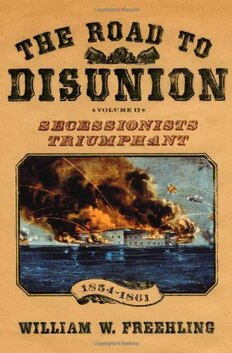
The Road to Disunion: Volume II: Secessionists Triumphant, 1854-1861 PDF
02007·4.876 MB·English
Most books are stored in the elastic cloud where traffic is expensive. For this reason, we have a limit on daily download.
Preview The Road to Disunion: Volume II: Secessionists Triumphant, 1854-1861
Description:
It is one of the great questions of American history--why did the Southern states bolt from the Union and help precipitate the Civil War? Now, acclaimed historian William W. Freehling offers a new answer, in the final volume of his monumental history The Road to Disunion. Here is history in the grand manner, a powerful narrative peopled with dozens of memorable portraits, telling this important story with skill and relish. Freehling highlights all the key moments on the road to war, including the violence in Bleeding Kansas, Preston Brooks's beating of Charles Sumner in the Senate chambers, the Dred Scott Decision, John Brown's raid on Harper's Ferry, and much more. As Freehling shows, the election of Abraham Lincoln sparked a political crisis, but at first most Southerners took a cautious approach, willing to wait and see what Lincoln would do--especially, whether he would take any antagonistic measures against the South. But at this moment, the extreme fringe in the South took charge, first in South Carolina and Mississippi, but then throughout the lower South, sounding the drum roll for secession. Indeed, The Road to Disunion is the first book to fully document how this decided minority of Southern hotspurs took hold of the secessionist issue and, aided by a series of fortuitous events, drove the South out of the Union. Freehling provides compelling profiles of the leaders of this movement--many of them members of the South Carolina elite. Throughout the narrative, he evokes a world of fascinating characters and places as he captures the drama of one of America's most important--and least understood--stories. The long-awaited sequel to the award-winning Secessionists at Bay, which was hailed as "the most important history of the Old South ever published," this volume concludes a major contribution to our understanding of the Civil War. A compelling, vivid portrait of the final years of the antebellum South, The Road to Disunion will stand as an important history of its subject.
See more
The list of books you might like
Most books are stored in the elastic cloud where traffic is expensive. For this reason, we have a limit on daily download.
